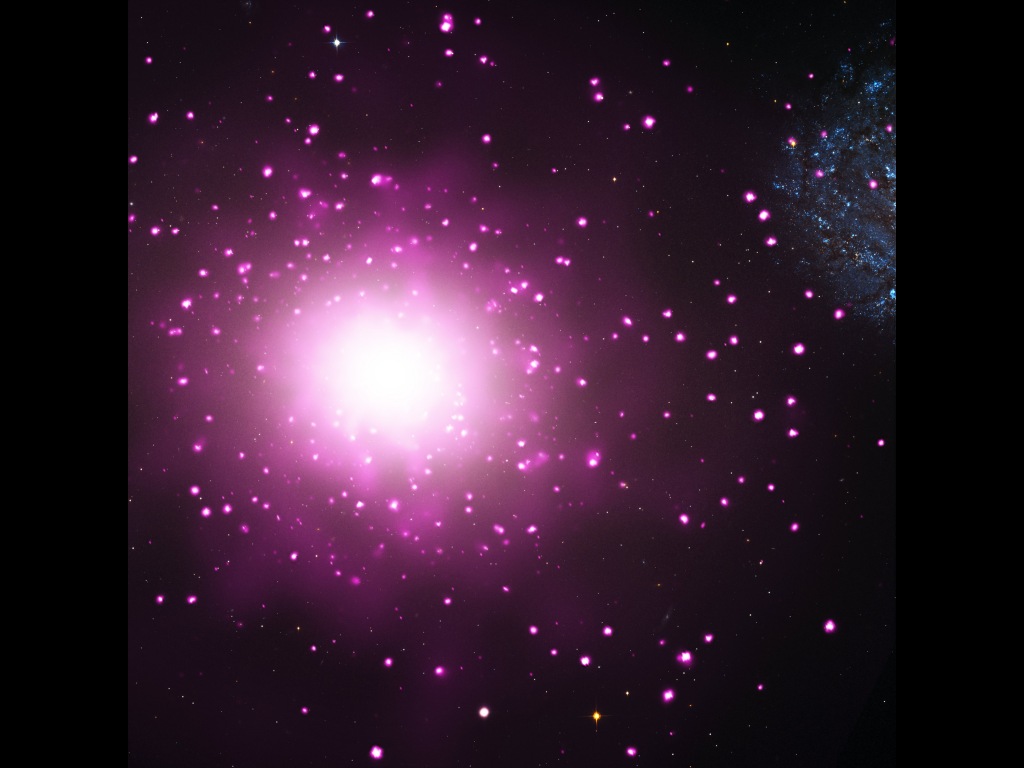If you began to travel to the star nearest to us after ol' Sol, named Alpha Centauri, it takes about four light years.
Now imagine there were instead 10,000 other stars crammed into that 25 trillion miles of space rather than none - that's the kind of density of a galaxy that was recently discovered.
M60-UCD1 is an ultra-compact dwarf galaxy near the massive elliptical galaxy NGC 4649, called M60, about 54 million light years from Earth, in the Virgo cluster of galaxies. It was discovered with NASA's Hubble Space Telescope and follow-up observations were done with NASA's Chandra X-ray Observatory and ground-based optical telescopes.
It is the most luminous known galaxy of its type and one of the most massive, weighing 200 million times more than our Sun, based on observations with the Keck 10-meter telescope in Hawaii. Remarkably, about half of this mass is found within a radius of only about 80 light years. This would make the density of stars about 15,000 times greater than found in Earth's neighborhood in the Milky Way, meaning that the stars are about 25 times closer.

Graphical representation. data from NASA's Chandra X-ray Observatory are pink and data from NASA's Hubble Space Telescope (HST) are red, green and blue. The Chandra image shows hot gas and double stars containing black holes and neutron stars and the HST image reveals stars in M60 and neighboring galaxies including M60-UCD1. The inset is a close-up view of M60-UCD1 in an HST image.
It has a bright X-ray source in its center. One explanation for this source is a giant black hole weighing in at some 10 million times the mass of the Sun.
"This galaxy is more massive than any ultra-compact drawfs of comparable size," said lead author Jay Strader, MSU assistant professor of physics and astronomy at Michigan State University, "and is arguably the densest galaxy known in the local universe."
What makes M60-UCD1 remarkable is that about half of its mass is found within a radius of only about 80 light years. This would make the density of stars about 15,000 times greater than found in Earth's neighborhood in the Milky Way.
"Traveling from one star to another would be a lot easier in M60-UCD1 than it is in our galaxy," Strader said. "Since the stars are so much closer in this galaxy, it would take just a fraction of the time."
The discovery of ultra-compact galaxies is relatively new – only within the past 10 years or so. Until then, astronomers could see these "things" way off in the distance but assumed they were either single stars or very-distant galaxies.
Another intriguing aspect of this galaxy is the presence of a bright X-ray source in its center. One explanation for this is a giant black hole weighing in at some 10 million times the mass of our sun.
Astronomers are trying to determine if M60-UCD1 and other ultra-compact dwarf galaxies are either born as really jam-packed star clusters or if they are galaxies that get smaller because they have stars ripped away from them. The possible massive black hole, combined with the high galaxy mass and sun-like levels of elements found in the stars, favor the latter idea.
A giant black hole at the center of M60-UCD1 helps tip the scales against the scenario where this galaxy was once a star cluster, since such large black holes are not found in these types of objects.
The galaxy was discovered using NASA's Hubble Space Telescope. Follow-up observations were done with NASA's Chandra X-ray Observatory and ground-based optical telescopes, including the Keck 10-meter telescope in Hawaii.
"Twenty years ago we couldn't have done this," Strader said. "We didn't have Hubble or Chandra. This is one of those projects where you bring together the full force of NASA's great observatories, plus ground-based resources."
Preprint: Jay Strader (Michigan St), Anil Seth (Utah), Duncan Forbes (Swinburne), Giuseppina Fabbiano (CfA), Aaron Romanowsky (San Jose St, Santa Cruz), Jean Brodie (Santa Cruz), Charlie Conroy (Santa Cruz), Nelson Caldwell (CfA), Vincenzo Pota (Swinburne), Christopher Usher (Swinburne), Jacob Arnold (Santa Cruz), 'The Densest Galaxy', arXiv:1307.7707
Upcoming in Astrophysical Journal Letters






Comments